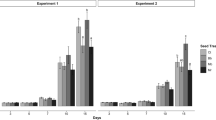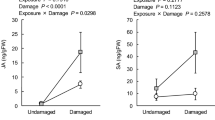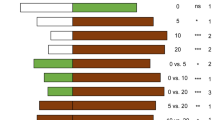Abstract
In this study we assessed the dynamic changes of 2-tridecanone in a herbivorous mite (Tetranychus urticae) on tomato (Lycopersicon esculentum, cv. ‘Moneymaker’), a plant with methyl ketones in the tetracellular tips of the glandular trichomes (Type VI). We showed that spider mites accumulate 2-tridecanone when foraging on cultivated tomato. Thus, the rate of mite–trichome contact multiplied by the amount of toxin per trichome tip exceeded the relative rate of toxin turnover multiplied by the amount of toxin per mite. The relative rate of toxin turnover was estimated to be 1.1 per day on cucumber, a plant without this toxin. The amount per trichome tip varied from 0.33 ng for middle-leaf trichomes to 1.26 ng for main-stem trichomes. Hence, to achieve a static level of 2-tridecanone equal to 8–17 ng per mite – representing the level we found in mites on middle leaves – the rate of mite–trichome contact should be 26–57 per day. Because methyl ketone apparently accumulates in the spider mites on tomato, the rate of mite–trichome contact is probably higher than that. We expect the accumulation of ketones to occur especially on the stems of cultivated tomato, since this is the area most densely occupied with glandular hairs and because here the hairs have higher levels of the methyl ketones.
Using dose–response relationships assessed earlier (Chatzivasileiadis and Sabelis, 1997, 1998), we estimated that the number of mite–trichome contacts causing 50% mortality per day is equal to 88 on a tomato stem, whereas it equals 70 for another strain of spider mites collected from cucumber. On wild tomato, L. hirsutum f. glabratum (PI 134417), just one to two contacts would suffice to cause 50% mortality per day. We suggest that methyl ketones from glandular hairs on tomato are an important mortality factor for spider mites on wild tomato and probably also on cultivated tomato.
Similar content being viewed by others
References
Barbour, J.D., Farrar Jr., R.R. and Kennedy, G.G. 1993. Interaction of Manduca sexta resistance in tomato with insect predators of Helicoverpa zea. Entomol. Exp. Appl. 68: 143-155.
Chatzivasileiadis, E.A. and Sabelis, M.W. 1997. Toxicity of methyl ketones from tomato trichomes to Tetranychus urticae Koch. Exp. Appl. Acarol. 21: 473-484.
Chatzivasileiadis, E.A. and Sabelis, M.W. 1998. Variability in susceptibility of Tetranychus urticae to 2-tridecanone from tomato trichomes: Effects of host plant shift. Exp. Appl. Acarol. 22: 455-466.
Dennehy, T.J., Farnham, A.W. and Denholm, I. 1993. The microimmersion bio-assay: A novel method for the topical application of pesticides to spider mites. Pestic. Sci. 39: 47-54.
Dimock, M.B. and Kennedy, G.G. 1983. The role of glandular trichomes in the resistance of Lycopersicon hirsutum f. glabratum to Heliothis zea. Entomol. Exp. Appl. 33: 263-268.
Dimock, M.B., Kennedy, G.G. and Williams, W.G. 1982. Toxicity studies of analogs of 2-tridecanone, a naturally occurring toxicant from a wild tomato. J. Chem. Ecol. 8: 837-842.
Farrar Jr., R.R. and Kennedy, G.G. 1987. 2-undecanone, a constituent of the glandular trichomes of Lycopersicon hirsutum f. glabratum: Effects on Heliothis zea and Manduca sexta growth and survival. Entomol. Exp. Appl. 43: 17-23.
Farrar Jr., R.R. and Kennedy, G.G. 1988. 2-undecanone, a pupal mortality factor in Heliothis zea: sensitive larval stage and in planta activity in Lycopersicon hirsutum f. glabratum. Entomol. Exp. Appl. 47: 205-210.
Kennedy, G.G. 1984. 2-tridecanone, tomatoes and Heliothis zea: potential incompatibility of plant antibiosis with insecticidal control. Entomol. Exp. Appl. 35: 305-311.
Kennedy, G.G. and Farrar, R.R. 1987. Response of insecticide-resistant and susceptible Colorado potato beetles, Leptinotarsa decemlineata to 2-tridecanone and resistant tomato foliage: the absence of cross resistance. Entomol. Exp. Appl. 45:187-192.
Kennedy, G.G., Yamamoto, R.T., Dimock, M.B., Williams, W.G. and Bordner, J. 1981. Effects of day length and light intensity on 2-tridecanone levels and resistance in Lycopersicon hirsutum f. glabratum to Manduca sexta. J. Chem. Ecol. 7: 707-716.
Lin, S.Y.H., Trunble, J.T. and Kumamoto, J. 1987. Activity of volatile compounds in glandular trichomes of Lycopersicon species against two insect herbivores. J. Econ. Entomol. 13: 837-850.
Luckwill, L.C. 1943. The genus Lycopersicon: historical, biological, and taxonomic survey of the wild and cultivated tomatoes. Aberdeen University Press, Scotland. 44 pp.
Rohlf, F.J. 1981. Critical values for correlation coefficients. In: Statistical Tables (2nd ed.), pp. 166-169. W.H. Freeman and Company, New York.
Sokal, R.R. and Rohlf, F.J. 1995. Linear Regression. In: Biometry, R.R. Sokal and F.J. Rohlf (eds.), pp. 451-554. W.H. Freeman and Company, New York.
Weston, P.A., Johnson, D.A., Burton, H.T. and Snyder, J.C. 1989. Trichome secretion composition, trichome densities, and spider mites resistance of ten accessions of Lycopersicon hirsutum. J. Amer. Soc. Hort. Sci. 114: 492-498.
Williams, W.G., Kennedy, G.G., Yamamoto, R.T., Thacker, J.D. and Bordner, J. 1980. 2-tridecanone, a naturally occurring insecticide from the wild tomato Lycopersicon hirsutum f. glabratum. Science 207: 888-889.
Author information
Authors and Affiliations
Rights and permissions
About this article
Cite this article
Chatzivasileiadis, E.A., Boon, J.J. & Sabelis, M.W. Accumulation and turnover of 2-tridecanone in Tetranychus urticae and its consequences for resistance of wild and cultivated tomatoes. Exp Appl Acarol 23, 1011–1021 (1999). https://doi.org/10.1023/A:1006394109643
Issue Date:
DOI: https://doi.org/10.1023/A:1006394109643




